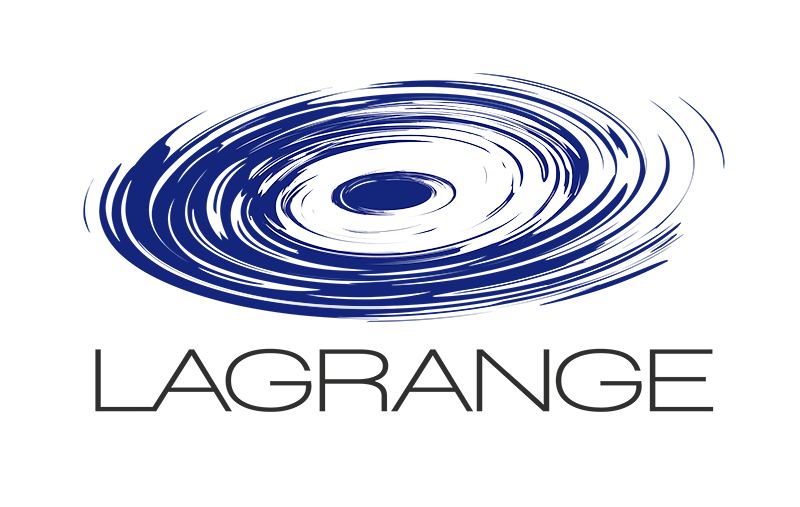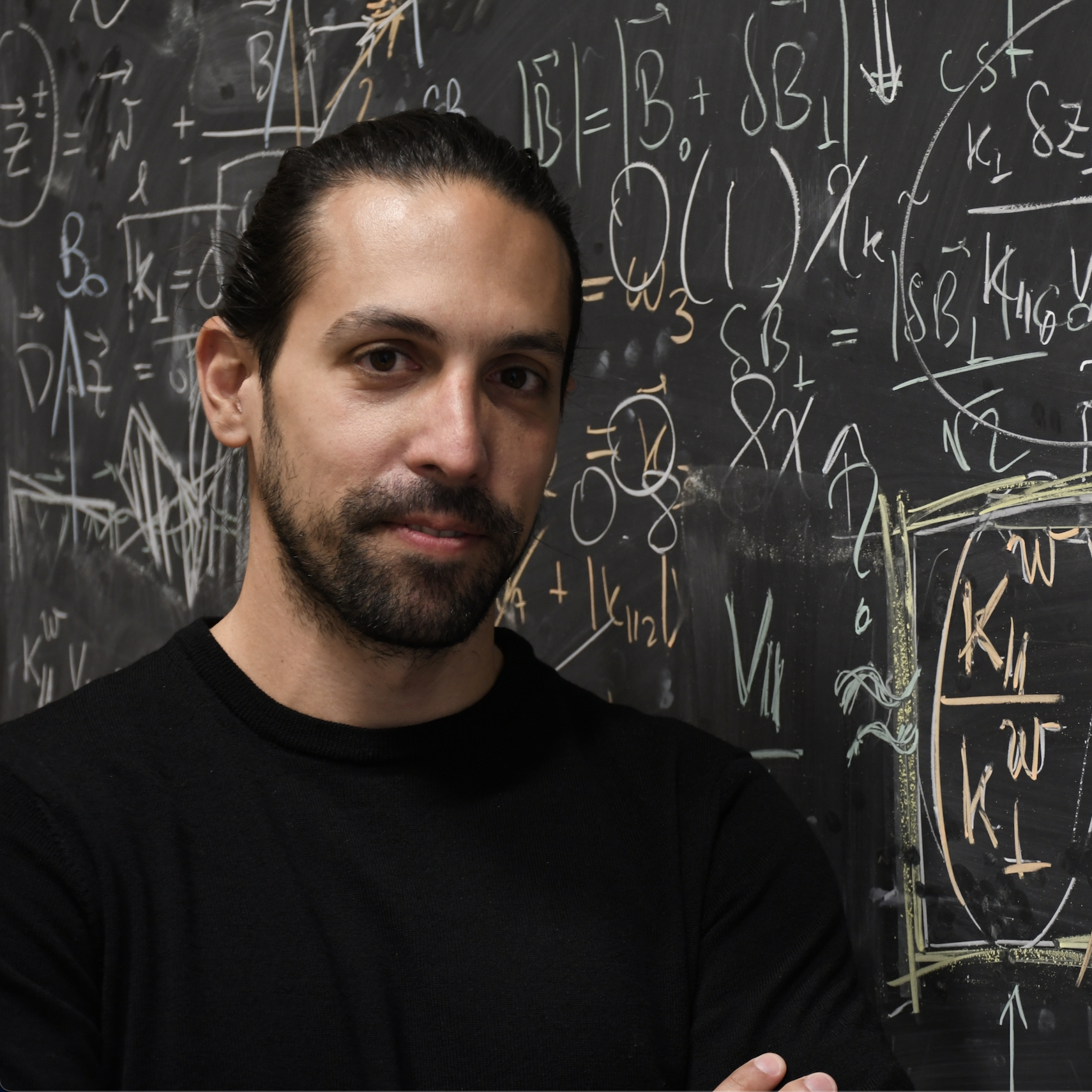
Les pages des membres du laboratoire Lagrange
Silvio Sergio CERRI
- Détails
position: CNRS researcher (Chargé de Recherche de Classe Normale, CRCN)
office: PHC N-15
address: Laboratoire Lagrange, Observatoire de la Côte d'Azur
Boulevard de l'Observatoire
CS 34229, 06304 Nice Cedex 4, France
phone: +33-4-92-00-30-48
email: silvio.cerri (at) oca.eu
ORCID: 0000-0003-0562-6574
Short Bio
After obtaining the B.Sc. degree (“Laurea Triennale") in Physics in 2009 and M.Sc. degree (“Laurea Magistrale”) in Astrophysics in 2012, both from the University of Pisa, I conducted my doctoral research at the Max Planck Institute for Plasma Physics (IPP) in Garching bei München and obtained my Ph.D. degree (“Dr. rer. nat.”) in 2015 from the University of Ulm.
I have been a Postdoctoral Research Associate and an Associate Research Scholar in the Department of Astrophysical Sciences at Princeton University (2017-2021), following a postdoctoral position in the Department of Physics at the University of Pisa (2016-2017) and a short "transitional" postdoc at IPP in Garching (Aug 2015 - Jan 2016).
Since October 2021, I have been recruited as permanent research staff at CNRS, joining the Laboratoire J.-L. Lagrange within the Observatoire de la Côte d’Azur in Nice.
P.I. of the ANR grant "MiCRO" (2023-2027) funded by the French National Research Agency.
Research Interests
MHD and kinetic plasma turbulence, cosmic-ray transport in the Galaxy, wind-magnetosphere interaction, turbulence in stratified geophysical fluids
Social Media
Linkedin: silvio-sergio-cerri-69888383
Twitter: @Silvio_S_Cerri
Publications
- Détails
For an up-to-date list, see here:
- Sioulas N., Velli M., Mallet A., Bowen T., Chandran B. D. G., Shi C., Cerri S. S., Liodis I., Ervin T., Larson D. E., Scale-Dependent Dynamic Alignment in MHD Turbulence: Insights into Intermittency, Compressibility, and Imbalance Effects (submitted)
- Sioulas N., Zikopoulos T., Shi C., Velli M., Bowen T., Mallet A., Sorriso-Valvo L., Verdini A., Chandran B. D. G., Martinovic M. M., Cerri S. S., Davis N., Dunn C., Higher-order analysis of three-dimensional anisotropy in imbalanced Alfvénic turbulence, Astrophys. J. (accepted)
- Foldes R., Marino R., Cerri S. S., Camporeale E., Characterization of local energy transfer in large-scale intermittent stratified geophysical flows via space filtering, Phys. Rev. Fluids 10, 043803 (2025)
- Cerri S. S., Revisiting the role of cosmic-ray driven Alfvén waves in pre-existing magnetohydrodynamic turbulence. I. Turbulent damping rates and feedback on background fluctuations, Astron. Astrophys. 688, A182 (2024)
- Granier C., Cerri S. S., Jenko F., Electron-only reconnection and ion heating in 3D3V hybrid-Vlasov plasma turbulence, Astrophys. J. 974, 11 (2024)
- Foldes R., Cerri S. S., Marino R., Camporeale E., Evidence of dual energy transfer driven by magnetic reconnection at sub-ion scales, Phys. Rev. E 110, 055207 (2024)
- Passot T., Cerri S. S., Granier C., Laveder D., Sulem P.-L., Tassi E., Gyrofluid simulations of turbulence and reconnection in space plasmas, Fundam. Plasma Phys. 11, 100055 (2024)
- Cerri S. S., Passot T., Laveder D., Sulem P.-L., Kunz M. W., Turbulent regimes in collisions of 3D Alfvén-wave packets, Astrophys. J. 939, 36 (2022)
👉 see also Animations !
- Cerri S. S., Arzamasskiy L., Kunz M. W., On stochastic heating and its phase-space signatures in low-β kinetic turbulence, Astrophys. J. 916, 120 (2021)
- Finelli F., Cerri S. S., Califano F., Pucci F., Laveder D., Lapenta G., Passot T., Bridging hybrid- and full-kinetic models with Landau-fluid electrons: I. 2D magnetic reconnection, Astron. Astrophys. 653, A156 (2021)
- Fornieri O., Gaggero D., Cerri S. S., De la Torre Luque P., Gabici S., The theory of cosmic-ray scattering on pre-existing MHD modes meets data, Mon. Not. R. Astron. Soc. 502, 5821 (2021)
- Sisti M., Fadanelli S., Cerri S. S., Faganello M., Califano F., Agullo O., Characterizing current structures in 3D hybrid-kinetic simulations of plasma turbulence, Astron. Astrophys. 655, A107 (2021)
[OPEN ACCESS] - Feraco F., Marino R., Primavera L., Pumir A., Mininni P., Rosenberg D., Pouquet A., Foldes R., Leveque E., Camporeale E., Cerri S. S., Charuvil Asokan H., Chau J., Bertoglio J.-P., Salizzoni P., Marro M., Connecting large-scale velocity and temperature bursts with small-scale intermittency in stratified turbulence, Europhys. Lett. 135, 14001 (2021)
- Cerri S. S., Camporeale E., Space-filter techniques for quasi-neutral hybrid-kinetic models, Phys. Plasmas 27, 082102 (2020)
- Califano F., Cerri S. S., Faganello M., Laveder D., Sisti M., Kunz M. W., Electron-only magnetic reconnection in plasma turbulence, Front. Phys. 8, 317 (2020)
[OPEN ACCESS]
- Cerri S. S., Groselj D., Franci L., Kinetic plasma turbulence: recent insights and open questions from 3D3V simulations, Front. Astron. Space Sci. 6, 64 (2019)
[OPEN ACCESS] - Dargent J., Lavorenti F., Califano F., Henri P., Pucci F., Cerri S. S., Interplay between Kelvin-Helmholtz and Lower-Hybrid Drift instabilities, J. Plasma Phys. 85, 805850601 (2019)
- Cerri S. S., Finite-Larmor-radius equilibrium and currents of the Earth's flank magnetopause, J. Plasma Phys. 84, 555840501 (2018)
- Cerri S. S., Kunz M. W., Califano F., Dual phase-space cascades in 3D hybrid-Vlasov-Maxwell turbulence, Astrophys. J. Lett. 856, L13 (2018)
- Fadanelli S., Faganello M., Califano F., Cerri S. S., Pegoraro F., Lavraud B., North-South asymmetric Kelvin-Helmholtz instability and induced reconnection at the Earth's magnetospheric flanks, J. Geophys. Res. Space Phys. 123, 9340-9356 (2018)
- Cerri S. S., Gaggero D., Vittino A., Evoli C., Grasso D., A signature of anisotropic cosmic-ray transport in the gamma-ray sky, J. Cosmol. Astropart. Phys. 10, 019 (2017)
- Cerri S. S., Califano F., Reconnection and small-scale fields in 2D-3V hybrid-kinetic driven turbulence simulations, Focus Issue on "Turbulence in Astrophysical and Laboratory Plasmas", New J. Phys. 19, 025007 (2017).
[OPEN ACCESS] - Cerri S. S., Servidio S., Califano F., Kinetic cascade in solar-wind turbulence: 3D3V hybrid-kinetic simulations with electron inertia, Astrophys. J. Lett. 846, L18 (2017).
- Cerri S. S., Franci L., Califano F., Landi S., Hellinger P., Plasma turbulence at ion scales: a comparison between PIC and Eulerian hybrid-kinetic approaches, J. Plasma Phys. 83, 705830202 (2017)
- Franci L., Cerri S. S., Califano F., Landi S., Papini E., Verdini A., Matteini L., Jenko F., Hellinger P., Magnetic reconnection as a driver for a sub-ion scale cascade in plasma turbulence, Astrophys. J. Lett. 850, L16 (2017)
- Groselj D., Cerri S. S., Banon Navarro A., Willmott C., Told D., Loureiro N. F., Califano F., Jenko F., Fully-kinetic versus reduced-kinetic modelling of collisionless plasma turbulence, Astrophys. J. 847, 28 (2017).
- Cerri S. S., Califano F., Jenko F., Told D., Rincon F., Subproton-scale cascades in solar wind turbulence: driven hybrid-kinetic simulations, Astrophys. J. Lett. 822, L12 (2016).
- De Camillis S., Cerri S. S., Califano F., Pegoraro F., Pressure anisotropy generation in a magnetized plasma configuration with a shear flow velocity, Plasma Phys. Control. Fusion 58, 045007 (2016).
- Cerri S. S., Pegoraro F., Califano F., Del Sarto D., Jenko F., Pressure tensor in the presence of velocity shear: stationary solutions and self-consistent equilibria, Phys. Plasmas 21, 112109 (2014).
- Cerri S. S., Banon Navarro A., Jenko F., Told D., Collision-dependent power law scalings in two dimensional gyrokinetic turbulence, Phys. Plasmas 21, 082305 (2014).
- Cerri S. S., Henri P., Califano F., Del Sarto D., Faganello M., Pegoraro F., Extended fluid models: pressure tensor effects and equilibria, Phys. Plasmas 20 112112 (2013).
- Henri P., Cerri S. S., Califano F., Pegoraro F., Rossi C., Faganello M, Sebek O., Travnicek P. M., Hellinger P., Frederiksen J. T., Norlund A., Markidis S., Keppens R., Lapenta G., Nonlinear evolution of the magnetized Kelvin-Helmholtz instability: from fluid to kinetic modeling, Phys. Plasmas 20 102118 (2013).
- Fornieri O., Gaggero D., Cerri S. S., De La Torre Luque P., Gabici S., Phenomenology of CR-scattering on pre-existing MHD modes, in proceedings of the ``37th International Cosmic Ray Conference -- ICRC2021'', PoS(ICRC2021)426.
- Vittino A., Cerri S. S., Gaggero D., Evoli C., Grasso D., Anisotropic propagation of Galactic cosmic-rays and spectral hardening in the Galactic Center, in proceedings of the ``35th International Cosmic Ray Conference -- ICRC2017'', PoS(ICRC2017)272.
- European Consortium for Astroparticle Theory (EuCAPT): Opportunities and Challenges for Theoretical Astroparticle Physics in the Next Decade (2021).
- Decadal Assessment of Plasma Science: Disentangling the Spatiotemporal Structure of Turbulence Using Multi-Spacecraft Data (2020).
- Califano F. & Cerri S. S., "Eulerian Approach to Solve the Vlasov Equation and Hybrid-Vlasov Simulations", in Space and Astrophysical Plasma Simulation: Methods, Algorithms, and Applications (ed. Büchner J.), Springer (2023). DOI: 10.1007/978-3-031-11870-8
- Cerri S. S., Plasma turbulence in the dissipation range - theory and simulations, Ph.D. Thesis, University of Ulm, Germany (2015).
- Cerri S. S., Fluid Modeling of Kinetic Effects in Collisionless Magnetized Plasmas and Application to Solar
Wind-Magnetosphere Interaction, M.Sc. Thesis, University of Pisa, Italy (2012).
Talks & Lectures
- Détails
Teaching Activity
- Fall 2022, 2023: "Introduction to weak and strong Alfvénic turbulence in magnetohydrodynamics", guest lectures for the Master course "Fisica dei Plasmi" (Physics of Plasmas), University of Pisa
- Fall 2016, 2018: "Introduction to fluid and plasma turbulence", guest lectures for the Master course "Plasmi A" (fluid theory of plasmas), University of Pisa
- Fall 2014, 2016: "Beyond magnetohydrodynamics: extended fluid models for collisionless plasmas", guest lectures for the Master course "Plasmi A" (fluid theory of plasmas), University of Pisa
- Spring 2016, 2017: "Vlasov theory of plasma waves", guest lectures for the Master course "Plasmi B" (kinetic theory of plasmas), University of Pisa
Invited Talks
- "Phase-space cascades in (simulations of) plasma turbulence", KITP program `Interconnections between the Physics of Plasmas and Self-gravitating Systems', Santa Barbara, CA, USA, July 2024
- "Plasma turbulence and cosmic-ray transport", Workshop `Plasma Physics in the High-Energy Universe', Toulouse, France, June 2024
- "A role for magnetic reconnection in anisotropic plasma turbulence", Transalpine workshop on magnetic reconnection and turbulence in space and fusion plasmas, Nice, France, May 2024
- "Turbulent regimes from interactions of 3D Alfvén-wave/kinetic-Alfvén-wave packets", AGU Fall Meeting, San Francisco, CA, USA, December 2023 (remote)
- "Sub-ion-scale turbulence and ion heating: recent results from 3D hybrid-kinetic simulations", Turbulent Energy Transfer in Space Plasmas workshop, Lyon, France, August 2023
- "Recent advances from hybrid-kinetic simulations of sub-ion-scale turbulence and ion heating", IUGG General Assembly - IAGA Symposium, Berlin, Germany, July 2023
- "Micro-physics of cosmic-ray transport: the MiCRO project", CFRCOS4: 4ème atelier de la communauté française du rayonnement cosmique, Montpellier, France, July 2023
- "Cosmic-ray transport (in the Galaxy): a micro-physics perspective", SERPENTINE Symposium, Toulouse, France, June 2023 (remote)
- "Turbulent regimes in collisions of 3D Alfvén-wave packets", Journées SF2A, Besançon, France, June 2022
- "Small-scale turbulence and energy conversion in kinetic plasmas", AGU Fall Meeting (moved to e-conference because of COVID-19), December 2020
- "Kinetic turbulence and ion heating in the solar wind", AAPPS-DPP - 4th Asia-Paci c Conference on Plasma Physics (moved to e-conference because of COVID-19), October 2020
- "Ion heating in low- β kinetic plasma turbulence", Max-Planck/Princeton Center (MPPC) Meeting, Gottingen, Germany, January 2020
- "Reconnection and ion heating in low-β plasma turbulence", 6th Vlasovia Conference, Strasbourg, France, July 2019
- "The good, the bad and the ugly: kinetic plasma turbulence in a 3D3V phase space", Waves Côte d'Azur, Nice, France, June 2019
- "3D hybrid-kinetic turbulence and phase-space cascades in a β ~ 1 plasma", 11th Plasma Kinetics Working Meeting, Wolfgang Pauli Institute, Vienna, Austria, July 2018
- "3D hybrid-Vlasov-Maxwell turbulence: reconnection, spectral anisotropy and dual phase-space cascades", Max-Planck/Princeton Center (MPPC) Meeting, Princeton, USA, April 2018
- "Magnetic reconnection as primary driver of the turbulent cascade below the ion gyroradius: hybrid-kinetic simulations", 1st JPP Frontiers in Plasma Physics Conference, Spineto, Italy, June 2017
- "Subproton-scale cascades in driven hybrid-kinetic plasma turbulence", Max-Planck/Princeton Center (MPPC) General Meeting, Berlin, Germany, January 2016
Invited Seminars
- "Cosmic-ray transport in the Galaxy: a micro-physics perspective", PlasmaAstro Seminar, IPP Garching, Germany, May 2025
- "The role of magnetic reconnection in Alfvén-wave/kinetic-Alfvén-wave turbulence: 3D Hamiltonian gyrofluid simulations", TOK Seminar, IPP Garching, Germany, May 2025
- "The many faces of Alfvénic turbulence and the role of magnetic reconnection", CmPA Seminar, KU Leuven, Belgium, May 2025
- "When astroparticles meet plasma turbulence: micro-physics of cosmic-ray transport in the Galaxy", IRAP Seminar, Institut de Recherche en Astrophysique et Planétologie, Toulouse, France, June 2022
- "Reconnection and ion heating in low-β hybrid-kinetic plasma turbulence", Lagrange Seminar, Observatoire de la Côte d'Azur, Nice, France, November 2019
- "Kinetic plasma turbulence: recent insights and open questions from numerical simulations", Plasma Physics Seminar, University of Maryland, USA, October 2019
- "Kinetic plasma turbulence in a 3D3V phase space", Space Plasma Seminar, University of Pisa, July 2019
- "Insights on kinetic-range plasma turbulence form a hybrid-kinetic approach: turbulent magnetic reconnection and cascades in phase space", Fluids & Plasmas Seminar, University of Delaware, USA, November 2018
- "On the role of magnetic reconnection in kinetic-range turbulence and the existence of phase-space cascades: hybrid-Vlasov-Maxwell simulations", Heliophysics Seminar, Princeton Plasma Physics Laboratory, USA, May 2018
- "Solar-wind turbulence in the kinetic range: a hybrid-kinetic approach", Astroplasmas Seminar, Princeton University, USA, October 2017
- "A hybrid-kinetic approach to solar wind turbulence in the kinetic range", Space Plasma Seminar, University of Pisa, Italy, September 2017
- "Hybrid-kinetic approach to solar-wind turbulence below the ion gyroradius: what have we learned?", Space Physics Seminar, University of California, Los Angeles, USA, November 2016
Other Contributed
- "Revisiting the turbulent damping of cosmic-ray driven Alfvén waves", PCTS workshop `Synergistic approaches to particle transport in magnetized turbulence: from the laboratory to astrophysics', Princeton University, NJ, USA, April 2024
- "Turbulent regimes from interactions of 3D Alfvén-wave/kinetic-Alfvén-wave packets", Cosmic Turbulence and Magnetic Fields: physics of baryonic matter across time and scales, Cargese, France, September 2023
- "Turbulent regimes in collisions of 3D Alfvén-wave packets", Arcetri Workshop on Plasma Astrophysics, Florence, Italy, November 2022
- "Configuration-space behaviour of scale-to-scale energy transfer in anisotropic fluid and plasma turbulence", AGU Fall Meeting (moved to e-conference because of COVID-19), December 2020
- "Reconnection and ion heating in low-β hybrid-kinetic plasma turbulence", APS-DPP Annual Meeting, Ft. Lauderdale, Florida, USA, October 2019
- "Reconnection and ion heating in low-β hybrid-kinetic plasma turbulence", KITP Conference on 'Connecting micro and macro scales: acceleration, reconnection, and dissipation in astrophysical plasmas', Santa Barbara, California, USA, September 2019
- "Plasma turbulence in phase space: 3D-3V hybrid-Vlasov-Maxwell simulations", AGU Fall Meeting, Washington, D.C., USA, December 2018
- "Anisotropic phase-space cascades in 3D-3V hybrid-Vlasov-Maxwell simulations of plasma turbulence", APS-DPP Annual Meeting, Portland, Oregon, USA, October 2018
- "Electron-only reconnection & cascades in phase space: recent results from hybrid-kinetic plasma turbulence", Arcetri Workshop on Plasma Astrophysics, Arcetri, Italy, October 2018
- "Anisotropic Kinetic Plasma Turbulence in Phase Space: 3D-3V Hybrid-Vlasov-Maxwell Simulations", 13th International School/Symposium for Space Simulations (ISSS-13), University of California, Los Angeles, USA, September 2018
- "3D3V hybrid-kinetic simulations with electron inertia effects of kinetic-range solar-wind turbulence", APS-DPP Annual Meeting, Milwaukee, Wisconsin, USA, October 2017
- "High-resolution 2D3V simulations of forced hybrid-kinetic turbulence", APS-DPP Annual Meeting, San Jose, California, USA, November 2016
- "Spectra, reconnection and small-scale fields in forced 2D3V hybrid-Vlasov turbulence", Arcetri Workshop on Plasma Astrophysics, Arcetri, Italy, October 2016
- "Forced hybrid-kinetic plasma turbulence in 2D3V", Italian Physics Society - National Congress, Padova, Italy, September 2016
- "Forced hybrid-kinetic turbulence in 2D3V", 5th Vlasovia Conference, Copanello, Italy, June 2016
- "Dissipation processes in turbulent plasmas: Hybrid Vlasov-Maxwell simulations", German Physical Society Spring Meeting - Division of Plasma Physics, Bochum, Germany, March 2015
- "Extended MHD models and shear flow dynamics in magnetized plasmas", European Physical Society Conference on Plasma Physics, Berlin, Germany, June 2014
- "The role of collisions in 2D gyrokinetic turbulence: the freely decaying electrostatic case", German Physical Society Spring Meeting - Division of Plasma Physics, Berlin, Germany, March 2014
- "The role of collisions in 2D gyrokinetic turbulence: non-universalpowerlaws", 4th Vlasovia Conference, Nancy, France, November 2013
- "Extended two-fluid model for the study of shear flow dynamics in magnetized plasmas", APS-DPP Annual Meeting, Denver, Colorado, USA, November 2013
- "Finite Larmor radius effects for the modeling of space plasmas dynamics", International Summer School on Fundamental processes in space weather, Spineto, Italy, June 2012
CV
- Détails
Curriculum Vitae [ ![]() full version - PDF ]
full version - PDF ]
- Employment:
[🇫🇷] Oct 2021 - present: Permanent Research Staff ("Chargé de Recherche"), Laboratoire J.-L. Lagrange, Observatoire de la Côte d'Azur, Nice, France.
[🇺🇸] Sept 2020 - Aug 2021: Associate Research Scholar, Department of Astrophysical Sciences, Princeton University, USA.
[🇺🇸] Sept 2017 - Aug 2020: Postdoctoral Research Associate, Department of Astrophysical Sciences, Princeton University, USA.
[🇮🇹] Feb 2016 - Aug 2017: Postdoctoral Researcher ("Assegnista di Ricerca"), Physics Department, University of Pisa, Italy.
[🇩🇪] Aug 2015 - Jan 2016: Postdoctoral Researcher ("6-months transitional postdoc"), Max Planck Institute for Plasma Physics (IPP), Garching, Germany.
- Education:
[🇩🇪] 2015: Ph.D. degree ("Dr. Rer. Nat.") from University of Ulm [c/o Max Planck Institute for Plasma Physics (IPP)] (magna cum laude).
Thesis: Plasma Turbulence in the Dissipation Range - Theory and Simulations.
Supervisor: Prof. Frank Jenko.
[🇮🇹] 2012: M.Sc. degree ("Laurea Magistrale") in Astronomy and Astrophysics, University of Pisa (110/110 cum laude).
Thesis: Fluid Modeling of Kinetic Effects in Collisionless Magnetized Plasmas and Application to Solar Wind-Magnetosphere Interaction (in english).
Supervisor: Prof. Francesco Califano.
[🇮🇹] 2009: B.Sc. degree ("Laurea Triennale") in Physics, University of Pisa (110/110 cum laude).
Thesis: Physical properties of the solar interior (in italian).
Supervisor: Prof. Scilla Degl'Innocenti.
Research Interests
- Détails
[UNDER CONSTRUCTION...]
- Plasma turbulence
In astrophysical and space plasmas, a multitude of phenomena lead to the generation and release of free energy, that in turn drive the onset of turbulence. Such energy is usually injected at large (''fluid'') scales and then is nonlinearly transferred towards smaller and smaller scales trough that process known as turbulent cascade. Differently from what happens in neutral fluids, in plasmas the cascade of turbulent fluctuations is biased by the magnetic-field direction, and at fluid scales it constitutes the so-called magneto-hydrodynamic (MHD) inertial range. Following such a cascade, in a collisionless plasma the energy will eventually reach the characteristic microscopic (''kinetic'') length scales of the plasma (the Larmor radius and/or the inertial length), leading to the onset of non-MHD turbulent regimes. In this ''kinetic range'', both collisionless damping, dispersive effects of plasma modes and ''micro-instabilities'', can strongly affect the turbulent dynamics and the energy cascade. This is an intrinsically multi-dimensional, nonlinear problem: it would require to solve the Vlasov equation for the evolution of each species' distribution function f(x,v) in the six-dimensional phase space, (x,v), under the influences of electromagnetic forces, whose evolution are in turn determined, via Maxwell equations, by the distribution of sources which is encoded in f itself. A full-kinetic approach with realistic parameters is still computationally untreatable due to the huge separation of spatial and time scales. However, in most of the cases of interest, one can actually exploit such separation of scales and adopt the so-called ``reduced-kinetic'' models. In such models, one practically neglects a certain class of plasma processes: this is the case of, e.g., gyrokinetic (GK) and hybrid-kinetic (HK) models.
A few more details for an interested reader. Gyrokinetics: By assuming that the gyration of the charged particles around the magnetic field is a process much faster than any dynamic evolution due to the turbulent fluctuations, GK reduces the velocity space accessible to particles from “3V”, (v||, v⟂, θ), to a “2V” domain, (v||, v⟂) (here || and ⟂ are with respect to B0, θ is the gyroangle). Physically, this corresponds to a reduction from the actual (fast) helicoidal motion of charged particles along magnetic-field lines, where particles could “abruptly jump” from one field line to another, to the description of “charged rings of current” moving along those lines and only slowly drifting perpendicular to them. GK does not include cyclotron resonances and stochastic heating, but retains Landau damping of both species. Hybrid-kinetics: The HK description makes no approximations on the ions, i.e., the Vlasov equation is solved for the ion distribution function in a complete 6D phase space, whereas electrons are treated as a neutralising fluid. HK models include Landau damping, cyclotron resonances and stochastic heating for ions, but the electron kinetic effects are neglected (this approximation can be partially relaxed also within a hybrid-kinetic model; see, e.g., Finelli et al., A&A 2021)
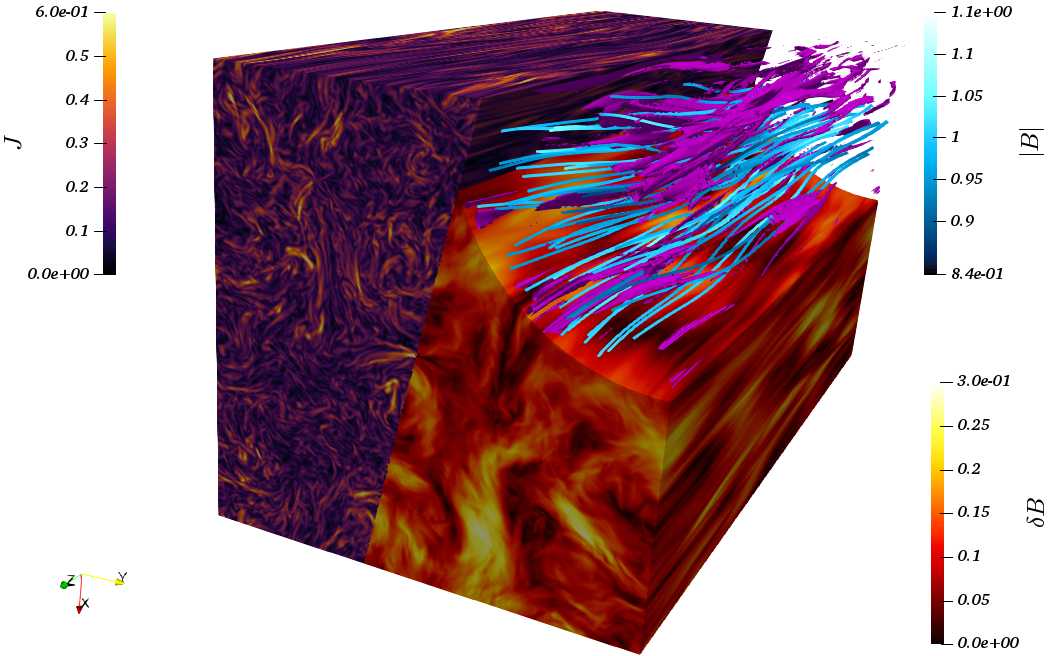
Figure. Three-dimensional rendering of current density, J, and magnetic-field fluctuations, δB.
Magnetic field lines with color-coded magnetic-field strength, |B|, are also shown, along with
embedded current density iso-surfaces (purple). The dataset used to produce this image is from
the "six-dimensional" (3D-3V: three-dimensional in both real and velocity spaces) simualtion
of kinetic turbulence at β=1 performed with the hybrid-Vlasov-Maxwell (HVM) code.
[ see Cerri et al., ApJL 846:L18 (2017) and Cerri et al., ApJL 856:L13 (2018) ]
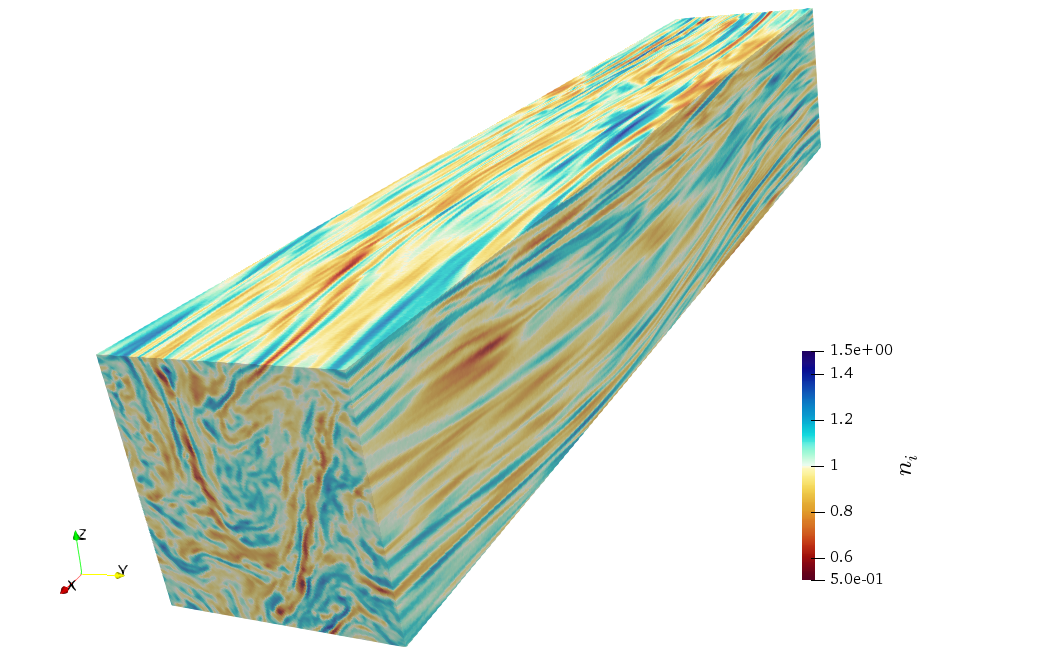
Figure. Three-dimensional rendering of ion density, ni, in a quasi-steady turbulent state.
The dataset used to produce this image is from a three-dimensional simualtion of continuously driven
kinetic turbulence at β ~ 0.1 performed with the hybrid particle-in-cell (PIC) code Pegasus++.
[ see Cerri et al., ApJ 916:121 (2021) ]
- Cosmic-ray transport in the Galaxy
The propagation of cosmic rays (CRs) through the turbulent interstellar medium (ISM) of our Galaxy is generally described in terms of the quasi-linear theory (QLT) of pitch-angle scattering on MHD waves, which is known to be strongly anisotropic with respect to magnetic-field direction and very sensitive to the properties of underlying turbulent fluctuations. However, the astro-particle community usually adopts a simplified phenomenological picture featuring just resonant pitch-angle scattering on Alfvén-wave packets and a constant, homogeneous diffusion coefficient, D0, throughout the Galaxy. This coefficient has been shown to have a power-law scaling with momentum-to-charge ratio (“rigidity”) p/Z, i.e., D0 ~ (p/Z)δ, and this parameter δ leaves a fingerprint in the propagated CRs spectra that are observed at the Earth. This simplified approach dates back to the early 60s, and was considered adequate to reproduce the available experimental data for a long time. However, such naive picture and its predictions have been seriously challenged both by theoretical arguments and by recent (direct and indirect) high-precision measurements. Beyond QLT, other plasma effects arising from CR–turbulence interaction itself play a relevant role within a self-consistent picture. Deriving accurate and self-consistent CR-propagation models in turbulent plasmas represent a great theoretical and numerical challenge, as it should relate the kinetic scales of CRs to the scale of the Galaxy itself (e.g., from ~ 10-6 to ~ 104 pc, respectively).
A few details for an interested reader. QLT theory, which is valid if the amplitude of the turbulent magnetic-field fluctuations δB is much smaller than the background field B0 (i.e., δB2/B02 << 1), formally predicts a highly anisotropic transport regime, where the ratio between the perpendicular and parallel diffusion coefficient is D⟂/D|| ~ F(k) ~ δBk2/B02 << 1 (here || and ⟂ are with respect to B0, and F(k) is the normalised power of the turbulent fluctuations δBk with wave vector k ~ 1/p, i.e. resonant with particles carrying momentum p). For instance, ISM turbulence is (mainly) injected by supernovae at scales LSN ~ 100 pc (and so one can assume δB/B0 ~ 1 at those scales). CR diffusion is provided by resonant scattering at the scale of the particle Larmor radius, rL: for typical galactic-CR energies, i.e., in the GeV–PeV range, their gyroradius is much smaller than the injection scales, rL << LSN (e.g., in a magnetic field of a few micro-Gauss, the Larmor radius of a CR with 1 GeV roughly corresponds to an astronomical unit, rL[1GeV] ~ 1013 cm ≈ 5 × 10-6 pc, i.e., (rL/LSN)1GeV ~ 10-7-10-8; and even at ~ 100 TeV, this ratio is just (rL/LSN)100TeV ~ 10-2-10-3). At those small scales (with respect to the injection scale) the turbulent power is extremely suppressed with respect to the injected one, so QLT is expected to hold. - Wind-magnetosphere interaction
Let us consider the Sun–Earth case. As soon as the supersonic, super-Alfv nic solarwind (SW) encounters the Earth, a magnetised shock (the “bow shock”), forms at the sunward boundaryof the Earth’s magnetopause. The shocked SW plasma forms the so-called “magnetosheath” and meets the Earth’s magnetosphere (MS). During mainly northward interplanetary magnetic field (IMF)conditions, no magnetic reconnection between the IMF carried by the solar wind and the Earth’s magneticfield could occur at the sunward MS boundaries. Therefore, accordingly to MHD theory, these two plasmas would not mix, and the shocked SW plasma just flows around the Earth’s magnetosphere. However, the velocity shear between such flowing SW and the stagnating MS plasma drives the Kelvin-Helmholtz instability (KHI) and the consequent formation of a (turbulent) mixing layer along the MS flanks, also due to secondary reconnetion and other non-ideal, kinetic instabilities (e.g., driven by pressure anisotropy and/or particle beams). This scenario provides an efficient mechanism for the entry of SW plasma and energetic particles into the MS. In general, depending on a planet’s magnetic field, wind–magnetosphere interaction determines the magnetospheric dynamics and, possibly, atmospheric loss. Thus, KHI, turbulence and other non-ideal plasma micro-instabilities (i.e., beyond the simple MHD description) play a crucial role in the coupling and transport between a stellar wind and a planet’s magnetosphere.
Animations
- Détails
Tearing-mediated turbulence via collisions of 3D Alfvén-wave packets
[ Reference: Cerri, Passot, Laveder, Sulem & Kunz, "Turbulent regimes in collisions of 3D Alfvén-wave packets" ApJ 939:36 (2022) ]
Basic ideas:
- If some sort of dynamic alignment takes place as the turbulent fluctuations cascade towards smaller and smaller scales, then in addition to the usual fluctuations' anisotropy with respect to the mean magnetic field, turbulent eddies become increasingly more sheared also in the field-perepndicular plane (i.e., fluctuations become more and more 3D anisotropic with decreasing scale).
- The above mechanism sets up a tearing-unstable configuration in the plane perpendicular to the mean magnetic field. If the turbulent eddies at a certain scale live long enough to allow the tearing instability to grow and disrupt them, then the turbulent cascade transtitions into the so-called tearing-mediated range.
- The turbulent-eddies' lifetime depends upon the large-scale nonlinearities (the strength of which can be defined through a nonlinearity parameter χ0, defined as the ratio between the Alfvén-wave linear propagation time and the nonlinear turnover time). The lower the nonlinearities are, the longer the lifetime of turbulent eddies will be. Therefore, by decreasing the nonlinearities at large scales ("weak cascade", χ0 < 1), one may expect to meet the conditions for a transition to the tearing-mediated range at scales that can be larger than those predicted for a cascade with strong large-scale nonlinearities ("critically balanced cascade", χ0 ~ 1 ).
Bottom line:
An initially weak cascade could allow tearing instability to onset and mediate the cascade at scales much larger than those predicted for a critically balanced cascade. Such a weak-to-tearing transition may even supplant the usual weak-to-strong transition in plasma turbulence.
Note: if html embedding of .mov videos right below does not work on your web browser, the same videos are also embedded as YouTube videos at the bottom of the page.
1. Very weak non-linearities at large scales (emerging tearing-mediated range)
Figure. Iso-contours of δB⊥/Brms for initial non-linearity parameter χ0 ∼ 0.1. Left: view of a slice in the x-y plane (i.e., plane perpendicular to B0) at z = L0/2. Right: view of δB⊥/Brms averaged over z.
2. Intermediate non-linearities at large scales (emerging tearing-mediated range)
Figure. Iso-contours of δB⊥/Brms for initial non-linearity parameter χ0 ∼ 0.5. Left: view of a slice in the x-y plane (i.e., plane perpendicular to B0) at z = L0/2. Right: view of δB⊥/Brms averaged over z.
3. Strong non-linearities at large scales (no tearing-mediated range):
Figure. Iso-contours of δB⊥/Brms for initial non-linearity parameter χ0 ∼ 1. Left: view of a slice in the x-y plane (i.e., plane perpendicular to B0) at z = L0/2. Right: view of δB⊥/Brms averaged over z.
1. Very weak non-linearities at large scales (emerging tearing-mediated range)
Figure. Iso-contours of δB⊥/Brms for initial non-linearity parameter χ0 ∼ 0.1 taken on a x-y plane (i.e., plane perpendicular to B0) at z = L0/2.
Figure. Iso-contours of δB⊥/Brms for initial non-linearity parameter χ0 ∼ 0.1 when an average over z is performed (z is the direction along B0).
2. Intermediate non-linearities at large scales (emerging tearing-mediated range)
Figure. Iso-contours of δB⊥/Brms for initial non-linearity parameter χ0 ∼ 0.5 taken on a x-y plane (i.e., plane perpendicular to B0) at z = L0/2.
Figure. Iso-contours of δB⊥/Brms for initial non-linearity parameter χ0 ∼ 0.5 when an average over z is performed (z is the direction along B0).
3. Strong non-linearities at large scales (no tearing-mediated range):
Figure. Iso-contours of δB⊥/Brms for initial non-linearity parameter χ0 ∼ 1 taken on a x-y plane (i.e., plane perpendicular to B0) at z = L0/2.
Figure. Iso-contours of δB⊥/Brms for initial non-linearity parameter χ0 ∼ 1 when an average over z is performed (z is the direction along B0).
ANR MiCRO
- Détails
Micro-physics of Cosmic-Ray Observables (MiCRO)
MiCRO is a 4-years research project funded by the French National Research Agency ("ANR"). The goals of the project are to improve theoretical models of cosmic-ray (CR) transport in the Galaxy based on the micro-physics of CR-turbulence interaction, and to pinpoint how these different models relfect onto the associated multi-messenger and multi-wavelength observables (i.e., direct detection of cosmic rays, gamma-ray and radio emission, neutrino fluxes).
MiCRO's key scientific question:
- How we model different type of plasma turbulence (both pre-existing and CR-generated), and how we self-consistently describe CR-transport considering these different models?
- What specific signatures belonging to these different scenarios can be found and/or predicted in the context of direct and indirect CR data from current and forthcoming experiments?
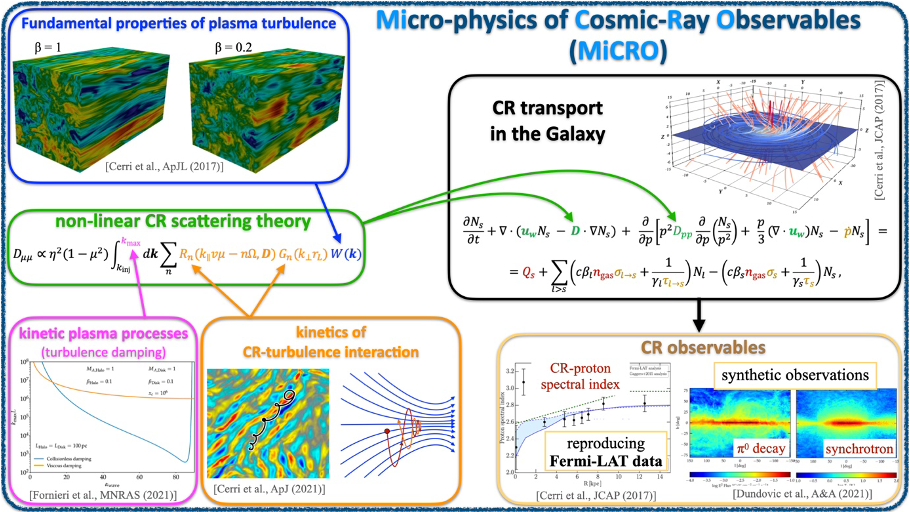
Figure. Schematic view of the physics addressed by the MiCRO project and its role in CR transport and observables.
Principal Investigator (P.I.):
- Silvio Sergio Cerri
Postdoc:
- Eleonora Puzzoni (Nov 2024 - )
Collaborators @ OCA-Lagrange:
- Thierry Passot
- Dimitri Laveder
- Pierre-Louis Sulem
External Collaborators:
- Pasquale Blasi (GSSI L'Aquila, Italy)
- Pedro De La Torre Luque (IFT Madrid, Spain)
- Daniele Gaggero (INFN Pisa, Italy)
- Yoann Genolini (LAPTh Annecy, France)
- Alexandre Marcowith (LUPM Montpellier, France)
- Philipp Mertsch (RWTH Aachen, Germany)
- Oreste Pezzi (CNR Bari, Italy)
- Illya Plotnikov (IRAP Toulouse, France)
UMR LAGRANGE
Observatoire de la Côte d’Azur
Boulevard de l’Observatoire
CS 34229 - F 06304 NICE Cedex 4
Tél. : +33 (0)4 92 00 30 11
Fax : +33 (0)4 92 00 30 33
